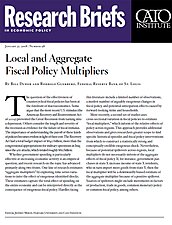The question of the effectiveness of countercyclical fiscal policies has been at the forefront of macroeconomics. Some argue that the most recent U.S. stimulus (the American Recovery and Reinvestment Act of 2009) prevented the Great Recession from turning into a depression. Others consider the length and severity of the recession as evidence for the failure of fiscal stimulus. The importance of understanding the payoff of these kinds of policies becomes evident in light of their cost. The Recovery Act had a total budget impact of $840 billion, more than the congressional appropriations for military operations in Iraq since the 9/11 attacks, which totaled roughly $815 billion.
Whether government spending is particularly effective at increasing economic activity is an empirical question, and recent research on the topic has advanced primarily along two fronts. One line of research estimates “aggregate multipliers” by exploiting time series variations to infer the effect of exogenous identified shocks. These estimates capture the total effect of spending on the entire economy and can be interpreted directly as the consequence of exogenous fiscal policy. Hurdles facing this literature include a limited number of observations, a modest number of arguably exogenous changes in fiscal policy, and potential anticipation effects caused by forward-looking firms and households.
More recently, a second set of studies uses cross-sectional variation in fiscal policies to estimate “local multipliers,” which inform of the relative effects of policy across regions. This approach provides additional observations and gives researchers greater scope to find specific historical episodes and fiscal policy interventions from which to construct a statistically strong and conceptually credible exogenous shock. Nevertheless, because of potential spillovers across regions, local multipliers do not necessarily inform of the aggregate effects of fiscal policy. If, for instance, government purchases in state X increase income of state X residents, who in turn import more goods from state Y, then the local multiplier will be a downwardly biased estimate of the aggregate multiplier because of a positive spillover. Sources of spillovers might include movements in factors of production, trade in goods, common monetary policy or common fiscal policy, among others.
We compare and then integrate the local and aggregate multiplier approaches. In doing so, we make five contributions. First, we construct a new dataset of annual federal defense contracts at the state level. We use military spending because it is plausibly exogenous with respect to the business cycle since it is likely driven by international geopolitical factors, rather than an endogenous countercyclical stimulus policy.
Second, we use changes in national defense spending to estimate aggregate income and employment multipliers.
Third, we use the state-level defense panel to estimate local income and employment multipliers. We find that the multipliers estimated with these two approaches are similar to one another for both employment and income. By estimating local and aggregate multipliers using the same dataset and identification scheme, these results provide the first empirical example in this literature to show that the local multipliers may provide reliable information about the aggregate effects of fiscal policy.
Fourth, recognizing the potential presence of cross-state spillovers, we use our panel to simultaneously estimate the direct effect of defense spending as well as the spillover effect of spending in one state on the economic activity of another state. We do find estimates of small positive spillovers between each state and its major trading partner. Summing the direct and spillover effect of government spending delivers an estimate with the state-level panel that is closer to the multiplier estimated with aggregate data.
The three estimation techniques explained above all point to one of our main conclusions: Across a wide range of specifications, we estimate income and employment multipliers between zero and 0.5. A cumulative income multiplier of 0.5 would imply that if there is a cumulative increase in military spending equal to 1 percent of national income in response to a defense-spending shock, then the cumulative change in national income equals 0.5 percent.
Fifth, we reconcile our finding of small income multipliers with the greater-than-one multipliers found in a related 2014 study by Nakamura and Steinsson. We do so by analyzing the impact of the Korean War in the estimation. We make three key points: (1) the addition of these data turns out to be crucial in estimating aggregate multipliers because, without the Korean War years, there is too little variation in defense spending to deliver precise estimates; (2) the inclusion of these data leads to significantly smaller income multipliers; and (3) we argue that it is appropriate to use Korean War data to draw conclusions about how government spending affects the economy in normal times. In particular, we contend that wartime conditions during the conflict in Korea were not nearly as extreme as the exceptional circumstances that characterized World War II’s command economy.
Though past studies have conceptually addressed the difference between local and aggregate fiscal multipliers, our paper is the first to quantitatively examine this distinction. We find that the aggregate and state-level approaches deliver similar estimates for income and employment multipliers, which are between zero and 0.5. These results provide the first empirical example in the literature in which local multipliers may be a reliable indicator of the aggregate effects of fiscal policy.
NOTE:
This research brief is based on Bill Dupor and Rodrigo Guerrero, “Local and Aggregate Fiscal Policy Multipliers,” Journal of Monetary Economics 92, December 2017: 16–30, https://doi.org/10.1016/j.jmoneco.2017.07.007. The analysis set forth does not reflect the views of the Federal Reserve Bank of St. Louis or the Federal Reserve System. The Cato Institute did not fund this study.
About the Authors
Bill Dupor and Rodrigo Guerrero, Federal Reserve Bank of St. Louis.
